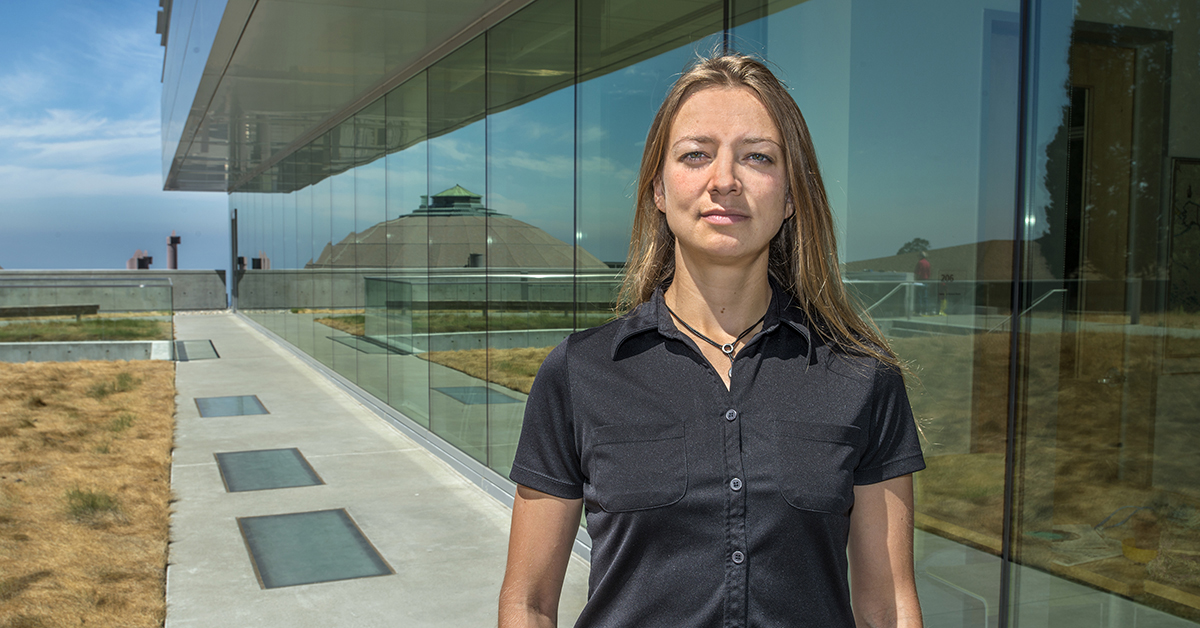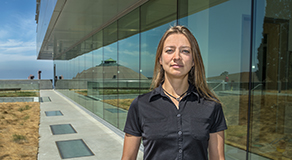
Juliane Mueller, a research scientist in the Computational Research Division, is developing an “optimization algorithm” toolset that pinpoints which variables of a “black box” simulation model will churn out the most realistic data in less time. Her work is supported by an Early Career Laboratory Directed Research and Development Award announced last November. (Credit: Roy Kaltschmidt/Berkeley Lab)
“What would happen if …?” To answer that question, scientists – whether they’re studying climate science or cosmology – rely on computer simulations to bring their abstract data to life in 3D. The process is painstakingly slow, however: One simulation can take up to a million CPU (central processing unit) hours on a supercomputer.
But according to Juliane Mueller, a research scientist in the Computational Research Division of the U.S. Department of Energy’s Lawrence Berkeley National Laboratory (Berkeley Lab), simulation work doesn’t have to take that long. For the past year, she has been leading an effort to develop an “optimization algorithm” toolset that figures out which variables or “parameters” of a simulation model – what Mueller calls a “black box” – will churn out the most realistic data in less time, and therefore make the most efficient use of supercomputers.
A better path to world-class science
All simulation models contain parameters – in the case of climate science, for example, the parameters used in cloud simulations significantly impact a climate model’s predictive ability. Choosing the correct parameters is critical to ensuring the model is close to your observations, said Mueller, but without an efficient, automated way to sift through the massive number of possible parameter combinations, scientists often have to rely on guesswork to find the best ones.
“They might have to try a thousand different combinations, and out of this thousand they might take the best one, or choose parameters based on previous results from a published paper,” she said. “But if there’s no published paper available, some people go through their data manually and guess which parameters seem to make the most sense to them.”
Neither of those scenarios is optimal, she added, because scientists would still need to run a simulation to see if the parameters are correct – akin to assembling an unlabeled rocket model kit to see what you’ve got. And testing just one set of parameters – of cloud formations, different gases coming out of the ground, or chemical reactions, for example – can take a day or more of computation.
Next step: a real-world equation
Mueller wants to take the guesswork out of the equation and replace it with her toolset – a suite of efficient search algorithms that automatically finds the best parameters so that researchers’ simulations and observations are in agreement with each other, she said. That way, they will only have to do the hard work on the best data.
Now that she is in the second year of her project, Mueller hopes to further improve her algorithms’ ability to remove “noise” – irrelevant data – from the simulations, and figure out how the toolkit could be used for smart building design. “It’s exciting to have this opportunity,” she said. “Berkeley Lab is the perfect place for this type of work because of the endless possibilities for collaborating across the sciences,” she said. “At the Lab, I get to see the real-world impact of my work – that’s always been my dream.”
###
Mueller’s work on the optimization algorithm toolset is supported by an Early Career Laboratory Directed Research and Development Award announced last November.
